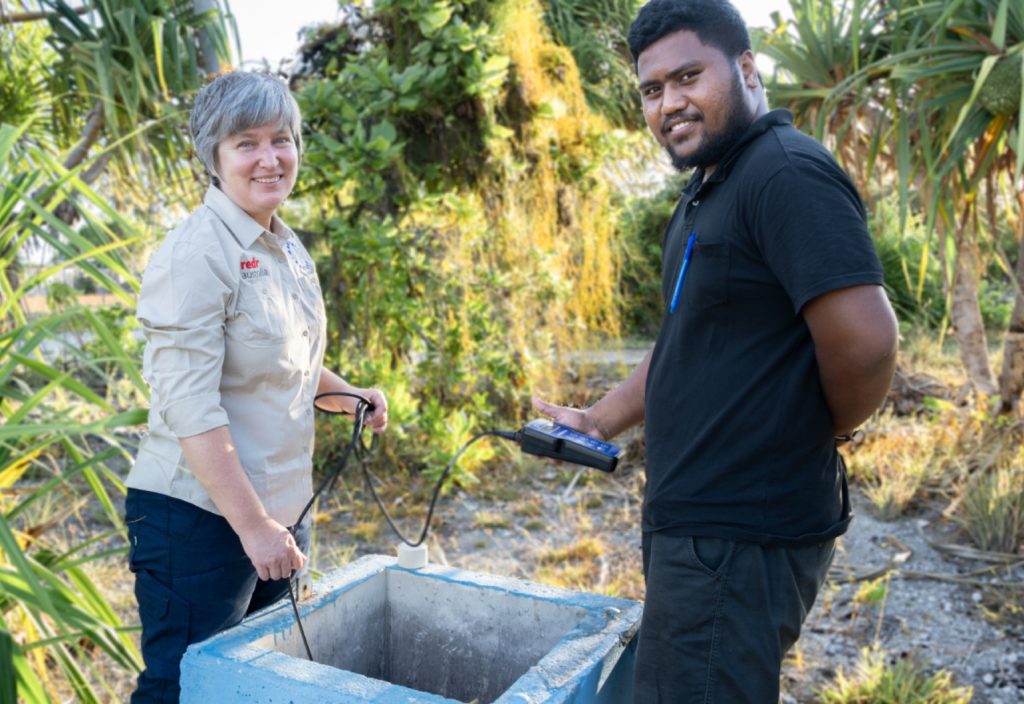Civil engineer and Australia Assists deployee Kirsty Jones shares how the Australia Assists humanitarian program is addressing threats to the freshwater supply in Kiribati.
Civil and water engineer Kirsty Jones, who has worked for Hunter Water in NSW for the past 15 years, took a three-month sabbatical in late 2022 to join an Australia Assists international aid deployment to Kiribati, implemented by RedR Australia.
She joined an internationally trained team of local engineers and specialists at the Kiribati Ministry of Infrastructure and Sustainable Energy as a WASH and Logistics Advisor.
“I’d been working across a variety of areas at Hunter Water, including asset management, strategy and drought response,” Jones told create. “But I was keen to get back into international work.”
Through her Australia Assists deployment, Jones worked to improve systems of securing safe drinking water by desalinating groundwater for the local population.
“There is increasing salinity across groundwater supplies in Kiribati, which form the country’s main source of water,” Jones said.
“Being a very low-lying country, there are also challenges relating to climate change, and they are in the process of conducting some massive upgrades to their water supply system on the main island of Tarawa.
“On top of that are pollution issues in the groundwater and a drought which has seen lower than average rainfall over the past three years.”
Despite the work being done by the ministry, the complex freshwater situation was fast becoming critical and extra hands were needed.
Not just a water problem
These factors sit in such a delicate balance that natural disasters and climate change can significantly affect the makeup of the nation’s water system.
“Kiribati is made up of small, sandy coral atolls,” Jones explained. “A layer of fresh water sits within the sand on top of the salt water, called a freshwater lens. As the tide comes in, the freshwater layer rises slightly, and as the tide goes out it drops.
“If anything spills onto the sand, it goes straight into the freshwater supply, which is very vulnerable to contamination and evaporation. You can imagine how, with rising sea levels, there is less of a chance these lenses will form.”
A greater frequency of high-intensity storms can lead to waves overtopping and contaminating the freshwater lens. This, combined with coastal erosion, is one of the ways climate change exerts its influence in the region.
“La Niña has meant that Kiribati has also had below-average rainfall, so there has been reduced recharge of these freshwater lenses over the last three years and led to a drought being declared,” Jones said.
“Freshwater lenses on the smaller islands were shrinking, meaning the available water was becoming saltier. You had a community whose water supply was slowly becoming more brackish and less drinkable, forcing them to walk much further — potentially to other parts of the island — to collect water.”
Water isn’t the only aspect of life in Kiribati affected by rising salination.
“It’s not just a water challenge. It’s also a food and nutrition challenge,” Jones said. “Industries and important fruit-bearing trees are impacted by increasing salinity.
“And on Tarawa, the main groundwater source is in what is supposed to be a protected land reserve. But with a growing population and land pressures, we’re seeing more and more settlements encroaching on the reserve, increasing the risk of contamination of this important drinking water source.”
[embedyt] https://www.youtube.com/watch?v=WtUkuvyhkFc[/embedyt]
Education and capacity building
Jones worked with local teams to identify solutions to these challenges, particularly when it came to plans to extract water for desalination from below the freshwater lenses – supplies that residents were likely relying on for drinking water.
“We asked for a more thorough technical review of their proposed design for intakes,” she said. “This was to make sure salt was being extracted deep enough below the freshwater lenses that the impact on those lenses was minimised.
“And with the push for the purchase of private desalination plants by local businesses, we looked at what kind of regulations the government may want to put in place in terms of getting those businesses to apply for licences.”
Jones also had numerous ad hoc opportunities to mentor young professionals.
“I ran technical sessions on how to read a pump curve, and looked at which sections of the Australian drinking water quality guidelines they might want to reference,” she said.
“That is what got me involved in engineering in the first place – a motivation to bring technical knowledge together with problems that communities are facing, and trying to find solutions to those challenges.”
Jones understands that long-term planning was just as relevant a component of her presence in the country as the practical assistance and knowledge sharing.
“It was really important, ultimately, to support local engineers and government officials to make an informed decision that works for their community,” she said.
“It’s not just responding to a disaster, but also about building up the resilience and long-term capacity of communities and governments to respond by themselves.”
Engineers interested in contributing their skills to RedR’s humanitarian activities can apply to join the organisation’s roster on its website or investigate its training courses. RedR also accepts donations.
